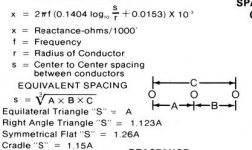You are using an out of date browser. It may not display this or other websites correctly.
You should upgrade or use an alternative browser.
You should upgrade or use an alternative browser.
NEC Chapter 9 Table 9
- Thread starter Tainted
- Start date
Julius Right
Senior Member
- Occupation
- Electrical Engineer Power Station Physical Design Retired
The resistance depends on conductor cross section area, length, temperature, frequency, and the distance between conductors. The factors which will change the conductor resistance -except the temperature and the length-there are skin effect-depending on frequency-and proximity effect-depending on frequency, conductor diameter and distance between conductors.
Each of these factors influencing on resistance are the same in conduit and cable tray system except the distance between conductors. Since usually proximity effect is small, we may neglect this and consider the same resistance as in conduit. The pipe effect -see Neher and McGrath article-it is not interesting in cable tray, so I think pvc conduit could be considered.
However, the reactance is very influenced by distance. If in a conduit the three phase conductors
are arranged in "cradle" the average distance may be less than as in "flat arrangement" but more than in triangle arrangement, I prefer an average.
Each of these factors influencing on resistance are the same in conduit and cable tray system except the distance between conductors. Since usually proximity effect is small, we may neglect this and consider the same resistance as in conduit. The pipe effect -see Neher and McGrath article-it is not interesting in cable tray, so I think pvc conduit could be considered.
However, the reactance is very influenced by distance. If in a conduit the three phase conductors
are arranged in "cradle" the average distance may be less than as in "flat arrangement" but more than in triangle arrangement, I prefer an average.
Julius Right
Senior Member
- Occupation
- Electrical Engineer Power Station Physical Design Retired
| Sorry.What I wanted to say in the "cradle" it is the average. |
Julius Right
Senior Member
- Occupation
- Electrical Engineer Power Station Physical Design Retired
I remember studying this stuff on my PE a while ago and doing practice problems lol.However, the manufacturer engineering handbook it is better. See calculation way per Okonite catalogue View attachment 2569349
Are there any tables out there showing the effects of the X and R when conductors are in wireway? I need them for short cicuit calculations.
If for example if have copper 500kCMIL THWN-2 wires in 8x8 metal wireway, what are the X and R values per 1000ft would that be?
JoeStillman
Senior Member
- Location
- West Chester, PA
If it's for short circuit calc purposes, why not just use the non-magnetic reactance? You'll be conservative. If the results don't put you into the next size AIC rating, call it a job well done.
In theory, what would the worst worst worst case scenario?If it's for short circuit calc purposes, why not just use the non-magnetic reactance? You'll be conservative. If the results don't put you into the next size AIC rating, call it a job well done.
Would it be bare non-insulated copper conductors in free air?
letgomywago
Senior Member
- Location
- Washington state and Oregon coast
- Occupation
- residential electrician
Superconductors = boomIn theory, what would the worst worst worst case scenario?
Would it be bare non-insulated copper conductors in free air?
So worst case would be liquid helium around the wire.
Well I mean realistic worst case scenarios.. lolSuperconductors = boom
So worst case would be liquid helium around the wire.
Julius Right
Senior Member
- Occupation
- Electrical Engineer Power Station Physical Design Retired
In order to calculate the maximum, short-circuit currents, according to IEC 60909-0, the resistance of lines(overhead lines and cables) are to be introduced at a temperature of 20oC.
Reactance minimal is then in equilateral triangle case.
IEEE 141/1993 Chapter 4 Short-circuit current calculations
4.5.2 Step 2:Collect and convert impedance data
Reactance minimal is then in equilateral triangle case.
IEEE 141/1993 Chapter 4 Short-circuit current calculations
4.5.2 Step 2:Collect and convert impedance data

MyCleveland
Senior Member
- Location
- Cleveland, Ohio
JR, hope you are well...In order to calculate the maximum, short-circuit currents, according to IEC 60909-0, the resistance of lines(overhead lines and cables) are to be introduced at a temperature of 20oC.
Reactance minimal is then in equilateral triangle case.
IEEE 141/1993 Chapter 4 Short-circuit current calculations
4.5.2 Step 2:Collect and convert impedance data View attachment 2569369
The answer to the original question is NEC 300.20 is it not ?
If all the feeders or BC's in the wireway are bundled, as they must be, you are back to standard cradle arrangement as Chap 9 Table 9 values are based on.
Your point on "MAX" is based on COLD START which should always be considered, but the the 20C could be lower dependent upon the application.
Make note that the Chap 9 Table 9 R values are based on 75C conductor temp, or basically the cable operating at its fully rated ampacity.

